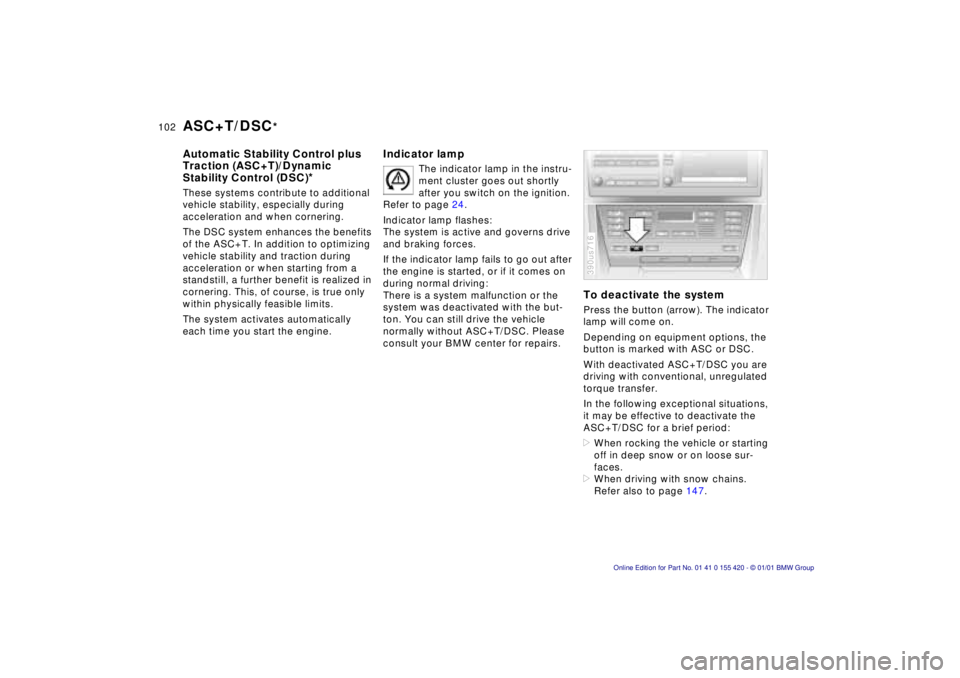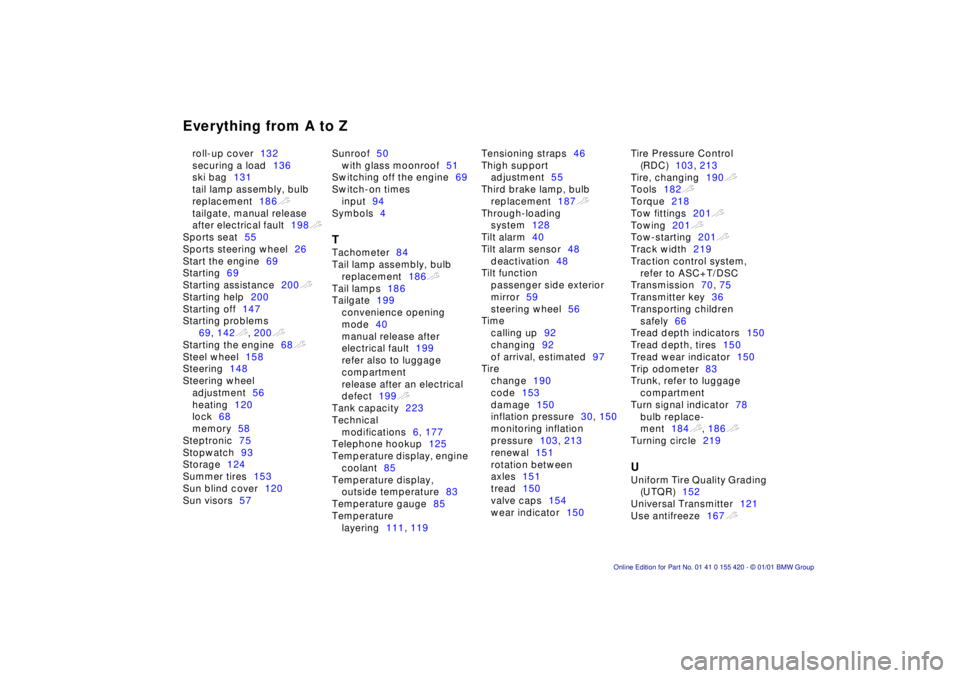Page 102 of 238

102n
ASC+T/DSC
*
Automatic Stability Control plus
Traction (ASC+T)/Dynamic
Stability Control (DSC)
*
These systems contribute to additional
vehicle stability, especially during
acceleration and when cornering.
The DSC system enhances the benefits
of the ASC+T. In addition to optimizing
vehicle stability and traction during
acceleration or when starting from a
standstill, a further benefit is realized in
cornering. This, of course, is true only
within physically feasible limits.
The system activates automatically
each time you start the engine.
To deactivate the systemPress the button (arrow). The indicator
lamp will come on.
Depending on equipment options, the
button is marked with ASC or DSC.
With deactivated ASC+T/DSC you are
driving with conventional, unregulated
torque transfer.
In the following exceptional situations,
it may be effective to deactivate the
ASC+T/DSC for a brief period:
>When rocking the vehicle or starting
off in deep snow or on loose sur-
faces.
>When driving with snow chains.
Refer also to page 147.390us716
Indicator lamp
The indicator lamp in the instru-
ment cluster goes out shortly
after you switch on the ignition.
Refer to page 24.
Indicator lamp flashes:
The system is active and governs drive
and braking forces.
If the indicator lamp fails to go out after
the engine is started, or if it comes on
during normal driving:
There is a system malfunction or the
system was deactivated with the but-
ton. You can still drive the vehicle
normally without ASC+T/DSC. Please
consult your BMW center for repairs.
Page 192 of 238

192nChanging a wheel
7 Position the jack at the jacking point
closest to the flat tire so that the
jack base is vertically below the
jacking point and the entire surface
of the head of the jack will move
into the square recess of the jacking
point (refer to the illustration detail)
when the jack is cranked.
8 Jack the vehicle up until the wheel you are changing is raised off the
ground.
9 Unscrew the lug bolts and remove the wheel.
10 Remove accumulations of mud or
dirt from the mounting surfaces of
the wheel and hub. Clean the lug
bolts.
390de350
11 Position the spare wheel. Secure the wheel by turning at least two lug
bolts into opposite bolt holes.
12 Screw in the remaining lug bolts. Tighten all the bolts securely.
13 Lower the jack and remove it from beneath the vehicle.
14 Tighten the lug bolts in a diagonal pattern.
15 Wheels with full wheel covers: Place the wheel cover with the valve
opening over the valve (arrow). Use
both hands to press the cover se-
curely onto the rim.
For this light-weight wheel, use
only the full wheel cover installed
by the factory. Other wheel covers may
not fit securely. <
390de360
16 Wheels with hub covers:
Position the hub cover and press it
on tightly.
17 If equipped with lug bolt covers: Align the arrow on the cover with
the line in the wheel and press the
cover into place.
18 Check and correct the air pressure at the earliest opportunity.
For vehicles with Tire Pressure
Control (RDC)
*:
After mounting the spare tire or cor-
recting the inflation pressure, reacti-
vate the system. Refer to page 103.
The vehicle jack is designed for
changing tires only. Do not
attempt to raise another vehicle model
with it or to raise any load of any kind.
To do so could cause accidents and
personal injury.
To ensure continued safety, have the
lug bolts checked with a calibrated
torque wrench [torque specification
72 lb-ft (100 Nm)] at the earliest
opportunity. <
Page 208 of 238

208nASC+T/DSC*
Precision sensors monitor the number
of revolutions of the wheels. When
equipped with DSC, they also monitor
steering angle, lateral acceleration,
brake pressure and the movement of
the vehicle around its vertical axis.
If differences in the wheel speeds
occur, the system counteracts the dan-
ger of wheelspin by reducing torque. If
necessary, the system also responds
with additional brake applications at the
rear wheels, and at all 4 wheels with
DSC.
In addition, DSC permanently monitors
the vehicle's current operating condi-
tion and compares it with an ideal con-
dition that is calculated from the sen-
sor's signals. If deviations from this
occur (understeering or oversteering,
for instance), DSC can stabilize the
vehicle in the fraction of a second by
reducing engine output and with the
assistance of braking intervention at in-
dividual wheels. As a result, dangerous
skids can be prevented even as they
are just beginning. You may need some time to become
accustomed to this system intervention.
However, it guarantees optimum drive
force and driving stability.
The braking intervention may be
accompanied by a certain degree of
noise.
Page 218 of 238
218n
BMW 525i/sport wagon BMW 530i BMW 540i/sport wagon
Displacement
Number of cylinders cu in (cm
m) 152.2 (2,494)
6 181.8 (2,979)
6268.4 (4,398)
8
Maximum output
at engine speed hp
rpm184
6,000 225
5,900282
5,400
Maximum torque
at engine speed Ib ft (Nm)
rpm175 (236)
3,500 214 (289)
3,500324 (440)
3,600
Compression ratio e10.5 10.2 10.0
Stroke
Bore in (mm)
in (mm)2.95 (75.0)
3.31 (84.0) 3.53 (89.6)
3.31 (84.0)3.26 (82.7)
3.62 (92.0)
Fuel-injection system Digital-electronic engine-management system
Engine specifications
Page 234 of 238

Everything from A to Zroll-up cover132
securing a load136
ski bag131
tail lamp assembly, bulb
replacement186t
tailgate, manual release
after electrical fault198t
Sports seat55
Sports steering wheel26
Start the engine69
Starting69
Starting assistance200t
Starting help200
Starting off147
Starting problems
69, 142t, 200t
Starting the engine68t
Steel wheel158
Steering148
Steering wheel
adjustment56
heating120
lock68
memory58
Steptronic75
Stopwatch93
Storage124
Summer tires153
Sun blind cover120
Sun visors57Sunroof50
with glass moonroof51
Switching off the engine69
Switch-on times
input94
Symbols4
TTachometer84
Tail lamp assembly, bulb
replacement186t
Tail lamps186
Tailgate199
convenience opening
mode40
manual release after
electrical fault199
refer also to luggage
compartment
release after an electrical
defect199t
Tank capacity223
Technical
modifications6, 177
Telephone hookup125
Temperature display, engine
coolant85
Temperature display,
outside temperature83
Temperature gauge85
Temperature
layering111, 119Tensioning straps46
Thigh support
adjustment55
Third brake lamp, bulb
replacement187t
Through-loading
system128
Tilt alarm40
Tilt alarm sensor48
deactivation48
Tilt function
passenger side exterior
mirror59
steering wheel56
Time
calling up92
changing92
of arrival, estimated97
Tire
change190
code153
damage150
inflation pressure30, 150
monitoring inflation
pressure103, 213
renewal151
rotation between
axles151
tread150
valve caps154
wear indicator150Tire Pressure Control
(RDC)103, 213
Tire, changing190t
Tools182t
Torque218
Tow fittings201t
Towing201t
Tow-starting201t
Track width219
Traction control system,
refer to ASC+T/DSC
Transmission70, 75
Transmitter key36
Transporting children
safely66
Tread depth indicators150
Tread depth, tires150
Tread wear indicator150
Trip odometer83
Trunk, refer to luggage
compartment
Turn signal indicator78
bulb replace-
ment184t, 186t
Turning circle219
UUniform Tire Quality Grading
(UTQR)152
Universal Transmitter121
Use antifreeze167t